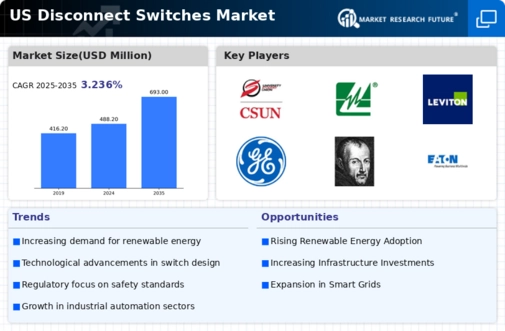Rising Demand for Renewable Energy
The increasing shift towards renewable energy sources in the US is driving the disconnect switches market. As solar and wind energy installations proliferate, the need for reliable disconnect switches becomes paramount. These devices ensure safe maintenance and operation of renewable energy systems. According to recent data, the renewable energy sector is projected to grow at a CAGR of approximately 10% over the next five years. This growth necessitates the integration of disconnect switches to manage the electrical flow safely. The disconnect switches market is thus poised to benefit from this trend, as utilities and private developers seek to enhance the safety and reliability of their renewable energy projects.
Increased Focus on Safety Standards
The disconnect switches market is experiencing growth due to heightened safety standards in the electrical industry. Regulatory bodies are continuously updating safety regulations to mitigate risks associated with electrical failures. This trend is particularly evident in sectors such as manufacturing and construction, where compliance with safety standards is critical. The disconnect switches market is likely to see increased demand as companies invest in equipment that meets or exceeds these regulations. Furthermore, the emphasis on safety is expected to drive innovation in disconnect switch technology, leading to more advanced and reliable products.
Infrastructure Upgrades and Modernization
Ongoing infrastructure upgrades across the US are significantly impacting the disconnect switches market. Aging electrical grids require modernization to improve efficiency and reliability. The US government has allocated substantial funding for infrastructure projects, with an estimated $1 trillion earmarked for improvements over the next decade. This investment is likely to enhance the demand for disconnect switches, which are essential for ensuring safe operations during maintenance and upgrades. The disconnect switches market stands to gain from these initiatives, as utilities and municipalities prioritize the replacement of outdated equipment with modern solutions that meet current safety standards.
Expansion of Electric Vehicle Infrastructure
The rapid expansion of electric vehicle (EV) infrastructure in the US is creating new opportunities for the disconnect switches market. As the number of EV charging stations increases, the need for reliable disconnect switches to manage electrical loads safely becomes essential. The US government has set ambitious targets for EV adoption, aiming for 50% of new vehicle sales to be electric by 2030. This shift is likely to drive demand for disconnect switches in charging stations and related infrastructure. The disconnect switches market is positioned to benefit from this trend, as manufacturers develop solutions tailored to the unique requirements of EV charging applications.
Technological Innovations in Electrical Equipment
Technological innovations in electrical equipment are significantly influencing the disconnect switches market. Advancements in materials and design are leading to the development of more efficient and durable disconnect switches. Innovations such as smart disconnect switches, which offer remote monitoring and control capabilities, are gaining traction in various sectors. The disconnect switches market is likely to see increased adoption of these advanced solutions as businesses seek to enhance operational efficiency and reduce downtime. Furthermore, the integration of IoT technology into disconnect switches may provide additional benefits, such as predictive maintenance and improved safety features.





















Leave a Comment